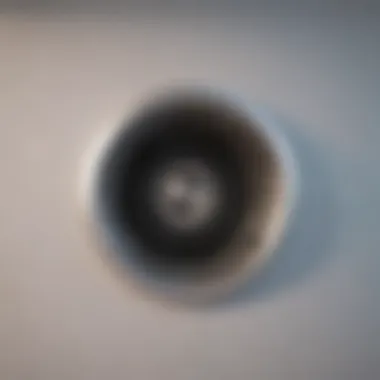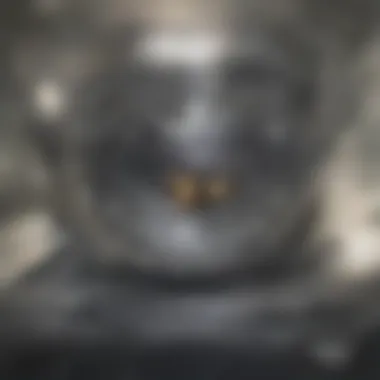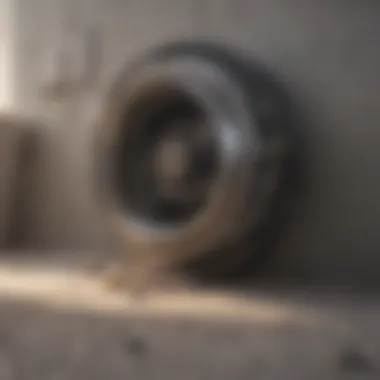Understanding Dryer Vent Maintenance: Frequency & Best Practices


Intro
Maintaining dryer vents is a crucial aspect of home management that often goes overlooked by many homeowners. Understanding how frequently these vents should be cleaned is essential for both optimal dryer performance and reducing fire risks. In this article, we will examine the implications of neglecting dryer vent maintenance, identify warning signs indicating a need for cleaning, and lay out best practices that are imperative for keeping dryer systems functioning effectively.
Neglect in this area can result in excessive lint buildup, which poses significant dangers. Lint is highly flammable and can lead to destructive fires if not addressed in a timely manner. By gaining insight into the frequency of maintenance and understanding the signs that indicate a need for action, homeowners can ensure safer and more efficient laundry routines.
Adding to this, best practices for the upkeep of these systems will be discussed in detail. A systematic approach to maintaining dryer vents not only enhances safety but also prolongs the lifespan of the appliance.
As we delve deeper into this topic, it will become evident why maintaining dryer vents should be prioritized in every household. Through actionable insights and frequency guidelines, this comprehensive guide serves to enhance overall awareness about dryer vent maintenance.
Prelude to Dryer Vent Cleaning
Dryer vent cleaning is a crucial aspect of home maintenance that many homeowners overlook. Regularly cleaning your dryer vent not only contributes to the efficiency of your dryer but also enhances safety in your home. Ensuring that lint does not accumulate in the vent reduces the risk of fire hazards, which is a significant concern when it comes to household appliances.
Importance of Dryer Vent Maintenance
The importance of dryer vent maintenance cannot be overstated. Clogged vents can lead to various issues, including longer drying times, increased energy bills, and a greater chance of fire. According to the U.S. Fire Administration, failure to clean dryers is one of the leading causes of household fires. Regular maintenance is an investment in safety and can prevent disaster. Additionally, maintaining clear dryer vents allows your appliance to operate efficiently, potentially extending its lifespan and saving you money on repairs or replacements.
Overview of The Cleaning Process
The cleaning process for dryer vents involves several steps. First, you need to unplug the dryer and move it away from the wall. Accessing the vent will allow you to inspect it for any lint or debris. Using a vacuum or a specialized dryer vent cleaning tool, you can remove the buildup of lint from the vent. This is best done periodically, typically every six months to a year, depending on usage. It's a straightforward task, but if the vent is deeply clogged, hiring professionals may be advisable. Understanding this process is vital as it empowers homeowners to take charge of their appliance maintenance effectively.
Frequency of Dryer Vent Cleaning
Maintaining the dryer vent is crucial for safety and efficiency. One key aspect of this maintenance is understanding how often to clean the vent. Regular cleaning can prevent dangerous situations and ensure that the appliance operates effectively. Without proper attention to cleaning frequency, users may experience inefficiencies that lead to increased energy costs. Therefore, determining the right schedule for cleaning becomes essential to safeguarding both the dryer and the home.
Recommended Cleaning Intervals
The general guideline for cleaning dryer vents suggests that homeowners should perform this task at least once a year. This frequency ensures that lint and debris do not accumulate to the point of blocking airflow. However, certain factors may call for more frequent cleaning.
Some specific recommendations include:
- Monthly checks: If the dryer is used heavily, consider inspecting the vent every month. This is particularly necessary for families with multiple members or if the dryer serves as a primary laundry tool.
- Semi-annual cleaning: For moderate use, a cleaning every six months might suffice. This is common for smaller households or those that use the dryer less often.
- Immediate cleaning: If unusual signs appear, such as longer drying times or burning smells, it is crucial to clean the vent without delay. These signs indicate a potential blockage that can pose fire risks.
By adhering to these guidelines, homeowners can create a maintenance routine that minimizes risks and promotes efficiency.
Factors Influencing Cleaning Frequency
Various elements can determine how often dryer vents should be cleaned. Understanding these factors can help individuals assess their specific situation better. Key considerations include:
- Dryer usage: The frequency of clothing washing and drying directly affects how much lint accumulates. The more often the dryer is used, the more frequently it needs to be cleaned.
- Type of dryer: Different models may have varying performance. For example, older dryers may struggle with lint buildup compared to modern appliances with better airflow technology.
- Household composition: Larger families generate more laundry, leading to increased lint production. In such cases, cleaning the vent more frequently might be necessary.
- Lint trap maintenance: Regularly cleaning the lint trap is important. If it is not maintained, excess lint can migrate to the vent, making cleaning more urgent.
Consistent assessments of these factors can help in deciding the appropriate cleaning frequency for your dryer vent, ensuring safe and efficient operation.
Consequences of Neglecting Dryer Vent Maintenance
Neglecting dryer vent maintenance can have dire implications for home safety and appliance efficiency. When a dryer vent is not properly maintained, various risks arise. Understanding these consequences is essential for promoting a safe and efficient laundry environment. This section will delve into the fire hazards associated with clogged vents and the impact on appliance performance.
Fire Hazards Associated with Clogged Vents
One of the most significant dangers of not maintaining your dryer vent is the increased risk of fire. Lint, which is a byproduct of the drying process, accumulates in the vent over time. If this buildup goes unnoticed, it can block airflow and cause the dryer to overheat.


When temperatures rise, lint can ignite, potentially leading to a fire that endangers lives and property. According to the National Fire Protection Association, failure to clean dryer vents is a leading cause of home dryer fires. The latter are often devastating and preventable with regular maintenance.
Steps to minimize fire risks include:
- Frequent Cleaning: Aim to clean your dryer vent at least once per year.
- Venting Material: Use metal venting materials instead of plastic, which can melt and catch fire more easily.
- Monitor for Signs: Pay attention to the signs of clogged vents, such as longer drying times or unusual heat near the dryer.
Decreased Appliance Efficiency
Another consequence of neglecting dryer vent maintenance is the significant decrease in appliance efficiency. A clogged vent forces the dryer to work harder, which can lead to increased energy consumption. This inefficiency not only raises utility bills but also wears down the dryer, potentially shortening its lifespan.
When a dryer cannot expel air effectively, the following issues may arise:
- Longer Drying Cycles: You may need to run the dryer multiple times to achieve dry clothes.
- Increased Wear and Tear: The machine's components become stressed and can fail prematurely.
- Potential Damage: Prolonged overheating can affect the dryer’s internal elements and lead to costly repairs.
To maintain appliance efficiency, consider implementing a maintenance schedule. This ensures that any lint buildup is addressed promptly.
"Regular maintenance of dryer vents is not just a good practice; it is a necessary action to safeguard your home and enhance appliance longevity."
Signs That Indicate a Need for Cleaning
Recognizing the signs that indicate a need for dryer vent cleaning is essential for maintaining both safety and efficiency. Addressing these signs promptly can prevent larger issues down the line. Ignoring them may lead to serious consequences, including fire hazards and decreased appliance efficiency. Therefore, understanding these signals allows homeowners to act quickly and ensure a safe drying environment.
Unusual Drying Times
One of the first indicators that your dryer vent might need cleaning is when clothes take an unusually long time to dry. If your dryer is running longer than normal, it might be struggling to push out warm, moist air due to a blocked vent. A clean dryer vent provides optimal airflow, allowing the appliance to function properly. Conversely, a clogged vent leads to build-up, causing heat to remain inside the dryer longer than necessary. This inefficiency not only increases your energy bills but can place extra strain on the machine, potentially shortening its lifespan. If you routinely have to run multiple cycles to achieve dry laundry, inspect your vent without delay.
Burning Odors during Operation
If you notice a burning smell while your dryer is in operation, this should raise immediate concern. Burning odors often suggest that lint is building up somewhere within the system, possibly even igniting from the heat generated during the drying process. The presence of these odors indicates that airflow is restricted, allowing lint to collect at key points. This condition poses a serious risk of fire, as lint is highly flammable. If you detect this smell, stop using the dryer and call for a professional inspection and cleaning. It is crucial to prioritize safety above all else when faced with such scenarios.
Excessive Lint Buildup
Visible lint accumulation around the dryer door, lint trap, and the vent itself serves as another clear sign that maintenance is necessary. While it is normal for some lint to gather, an excessive amount indicates that there may be a larger issue at play. Regular cleaning of the lint filter is essential, but this does not replace the need for vent cleaning. If lint can be seen outside the vent or around the dryer, it could mean that the passage is blocked. This not only impairs efficiency but also elevates the risk of fire. To mitigate this risk, it is advisable to inspect not just the dryer components, but also to check the external venting area for any obstructions.
Recognizing these signs early is vital. Prompt action can prevent extensive damage to your dryer and home.
Step-by-Step Guide to Cleaning Your Dryer Vent
Cleaning your dryer vent is an indispensable maintenance task that directly affects both the efficiency and safety of your appliance. This section will equip you with a methodical approach, ensuring that the cleaning process is straightforward but effective. Regular maintenance decreases the risk of lint buildup, which is a significant fire hazard. Additionally, a clean vent allows your dryer to work more efficiently, ultimately saving you on energy bills.
Gather Necessary Tools and Materials
Before starting, it is essential to gather all the necessary tools and materials to1 make your cleaning process effective. Here’s a list:
- Lint brush: A long and flexible lint brush is ideal for reaching deep into the vent.
- Vacuum Cleaner: Preferably with a hose attachment, to remove lint and debris.
- Screwdriver: Depending on your vent configuration, you might need to detach the vent cover or hose.
- Duct tape: Useful for re-sealing any joints and ensuring a tight connection.
- Protective gear: Gloves and safety glasses to protect against dust and debris.
Having these tools will provide a good foundation for a thorough cleaning.
Accessing the Dryer Vent
To clean the dryer vent effectively, you must first access the vent itself. Here’s how to do it:


- Unplug the Dryer: Safety is the priority, so disconnect the dryer from the electrical outlet.
- Move the Dryer: Carefully push the dryer away from the wall to gain access to the vent.
- Detach the Vent Hose: Use the screwdriver to loosen the clamp and remove the vent hose from the back of the dryer. This part is often connected to a wall duct. Check if there are additional screws or fasteners if it does not come off easily.
- Inspect the Exterior Vent: Do not forget to check the vent cover outside your home. Make sure it is not blocked and opens freely.
By accessing the vent properly, you ensure that you can clean every part thoroughly.
Cleaning Techniques
Now that you have access, employ effective cleaning techniques to make sure the vent is spotless:
- Manual Cleaning with a Lint Brush: Insert the lint brush into the vent and move it back and forth. Be gentle but firm enough to dislodge any stuck lint. Rotate the brush to cover all angles.
- Vacuuming: After using the lint brush, vacuum any remaining debris from both the interior and vent hose. When using the vacuum, focus on the areas unreachable by hand.
- Cleaning the Lint Trap: While the dryer is apart, check and clean the lint trap inside the machine. Lint can accumulate here too, affecting dryer performance.
- Reassemble and Test: Once cleaning is done, reattach the vent hose, using duct tape to ensure a tight seal. Plug the dryer back in, push it back into position, and run a short cycle to verify airflow.
Adopting these techniques will ensure that the dryer vent remains clear, thus enhancing efficiency and safety.
Hiring Professional Services
Maintaining a dryer vent is a crucial task, but there comes a point when professional assistance is beneficial. Hiring trained experts can enhance safety and ensure comprehensive cleaning. Not everyone has the experience or tools for effective maintenance. Professionals possess the right equipment and know-how to properly clean and inspect dryer vents. They can identify hidden issues that an average homeowner might overlook.
When to Consider Professional Help
There are specific scenarios that warrant calling a professional. One such case is if you notice significant lint buildup. If regular cleaning has not resolved persistent issues, professional help becomes essential. Another indicator is when your dryer takes longer than normal to dry clothes. This delay often results from obstructed airflow, which can indicate deeper issues that require expert evaluation.
Additionally, if you smell something burning while the dryer is running, do not hesitate to seek help. Such odors can signal major problems in the venting system, including electrical issues or excessive lint buildup. All these factors highlight the importance of engaging with skilled services when necessary.
Selecting a Reliable Service Provider
Choosing a trustworthy service provider for your dryer vent maintenance is important. Start by looking for companies with good reputations. Online reviews and customer testimonials can provide valuable insight into a company's reliability and quality of work. Check for certifications, too. A professional with suitable certifications or memberships in recognized associations can demonstrate their commitment to quality service.
Ask for a detailed quote before hiring a service. Ensure it covers inspection, cleaning, and any additional services they might suggest. A transparent provider should be willing to explain their process, so do not hesitate to ask questions. Take your time: selecting the right service can prevent future issues and prove beneficial in the long run.
Remember: Regular maintenance by experts can extend the lifespan of your dryer while enhancing its performance. Finding the right professional is a step toward a safer and more efficient laundry experience.
Maintaining Your Dryer Vent Post-Cleaning
Proper maintenance of your dryer vent after cleaning is a critical aspect often overlooked. Even after thorough cleaning, neglecting regular upkeep can lead to reaccumulation of lint and other debris. This not only affects the efficiency of your dryer but can also pose serious safety risks. Regular attention to your dryer vent ensures that it continues to operate at optimal performance. Continuing with maintenance practices can greatly reduce the risk of fire hazards, enhance energy efficiency, and prolong the life of your appliance.
Regular Inspection Practices
After your initial deep clean, integrating regular inspections into your routine is essential. Establish a schedule for inspections, ideally every few months, to ensure everything is functioning properly. During these checks, look for:
- Visible Lint Buildup: Check both the interior vent and the exterior exhaust for lint buildup.
- Blockages: Ensure there are no obstructions in the vent pipe, as these can hinder airflow.
- Wear and Tear: Look for any damage on hoses or ducting that may need to be replaced.
If you notice any issues, address them promptly to avoid further complications. Consider documenting your inspections to track any needed repairs or maintenance. This will help maintain a clear record of the vent's condition over time.
Long-Term Maintenance Tips
Long-term maintenance of your dryer vent involves more than infrequent cleaning. Here are some effective strategies:
- Educate Household Members: Make sure everyone who uses the dryer understands the importance of proper laundry practices. For example, they should clean the lint filter after each use.
- Use Quality Venting Products: Invest in high-quality, rigid duct material instead of flexible plastic ones. Rigid ducts have fewer bends and are less likely to trap lint.
- Consider Professional Inspections: In addition to your personal checks, schedule professional maintenance every year. These experts can provide a thorough clean and check for hidden issues.
- Look for Upgrades: If the dryer is older, consider investing in a newer model that emphasizes energy efficiency. Newer dryers come with improved designs that reduce the chances of lint buildup.
By adhering to these practices, you can maintain your dryer vent effectively. This ensures its longevity and safe operation, allowing you to enjoy the efficiency of your dryer for years to come.
Environmental Considerations


The maintenance of dryer vents extends beyond personal safety and appliance efficiency; it also plays a vital role in promoting a healthier environment. This section will discuss how proper dryer vent maintenance can contribute to energy conservation and sustainable practices, ultimately benefiting both the homeowner and the planet.
Energy Efficiency Benefits
Maintaining clean dryer vents significantly improves energy efficiency. When lint and debris accumulate in the vent, the dryer works harder to expel moisture. This inefficiency results in longer drying times and increased energy usage.
- Lower Energy Bills: Regular cleaning of the vent reduces the workload on the dryer, leading to decreased energy consumption. Homeowners can notice a reduction in their utility bills after maintaining a clean vent.
- Environmental Impact: Reduced energy usage contributes to lower carbon emissions. By improving the efficiency of dryers, less energy is drawn from potentially harmful sources such as fossil fuels.
- Appliance Longevity: Keeping dryer vents clean can prolong the life of the appliance. A less stressed machine means fewer repairs and replacements, which also contributes to resource conservation.
In essence, maintaining dryer vents is not just about efficiency but also about making a positive impact on the environment.
Recycling and Proper Disposal of Lint
Lint from dryers is often perceived as mere waste; however, it can be managed in environmentally friendly ways. Proper disposal and recycling of lint ensure that it does not contribute to landfill waste.
- Composting: Lint is primarily made of natural fibers (like cotton or linen) that can be composted. This practice reduces waste and returns valuable nutrients to the soil.
- Repurposing: Some crafters collect dryer lint to use as stuffing for pillows or other textile projects. Promoting the idea of reusing such materials helps reduce waste.
- Safe Disposal: When not composting or recycling, it is important to dispose of lint properly, ensuring it does not pollute the environment. Some municipalities have specific guidelines for textile waste disposal.
The management of dryer lint is an often-overlooked aspect of dryer maintenance that can significantly impact the environment.
Common Misconceptions about Dryer Vent Cleaning
In the realm of dryer vent maintenance, several misconceptions permeate the discussion. These misunderstandings can lead to improper cleaning practices or neglect of essential maintenance. It is critical to clarify these points to ensure the safety and efficiency of your dryer.
DIY vs Professional Cleaning
Many homeowners believe that dryer vent cleaning is primarily a simple DIY task. While minor lint removal can be done at home, achieving a thorough clean often requires the expertise and tools that only professionals possess.
- Limited Access: Some vents are not easily accessible. Professional services have specialized equipment like long hoses and powerful vacuums designed to reach deep into ducts.
- Comprehensive Cleaning: A professional can identify not just lint buildup but also other potential issues, such as poor installation or damage to the vent, that an untrained person may overlook.
- Time Factor: DIY cleaning can be time-consuming. Professionals can often complete the job in a fraction of the time, ensuring your dryer operates efficiently.
Homeowners should assess their capabilities realistically. In some cases, investing in professional cleaning services can be the more prudent choice.
Duration of Cleaning Necessity
Another common misconception is the notion that once a dryer vent is cleaned, it remains clear indefinitely. This idea might lead to neglect in regular maintenance schedules. The truth is that dryer vents can accumulate lint and debris over time, often exacerbated by frequency of use and the type of laundry being dried.
- Usage Patterns: Families that do laundry multiple times a week may require more frequent cleanings compared to those with infrequent use.
- Vent Design: Longer vent paths or non-standard installations can lead to quicker buildup, necessitating shorter intervals between cleanings.
- Manufacturer Recommendations: Many appliance manufacturers stipulate recommended maintenance intervals, emphasizing the need for attention even after a recent cleaning.
Understanding these nuances helps keep your dryer functioning at peak performance and ultimately saves energy and reduces fire risk.
"Regular maintenance is not just about avoiding problems; it’s about ensuring consistent performance and safety."
Addressing these misconceptions fosters a more informed approach to dryer vent maintenance. By knowing when to clean and when to seek professional help, homeowners can significantly improve both the lifespan of their appliances and their household safety.
Epilogue
In the realm of appliance maintenance, the significance of dryer vent upkeep cannot be overstated. Each element discussed throughout the article contributes to a greater understanding of how proper care enhances performance, efficiency, and safety.
Reiterating the Importance of Dryer Vent Maintenance
First and foremost, regular dryer vent cleaning prevents fire hazards associated with accumulated lint. Given that dryer fires can initiate from minor build-ups, timely cleaning becomes crucial. Adopting a maintenance routine not only safeguards your property but also protects your loved ones.
Beyond safety, neglecting dryer vent maintenance often leads to decreased appliance efficiency. The longer a dryer struggles to function due to clogging, the more energy it consumes. This inefficiency translates to higher utility bills for homeowners. Ensuring that vents remain clear is an investment in both safety and cost-effectiveness.
Highlights of Key Benefits
To summarize the advantages of diligent dryer vent maintenance:
- Increased Safety: Reducing fire hazards by eliminating lint build-up.
- Enhanced Efficiency: A well-maintained dryer operates more effectively, cutting down energy usage.
- Cost Savings: Lower utility bills and extended appliance lifespan.
In essence, the message is clear: prioritize dryer vent maintenance for a safer home and a more efficient appliance. The proactive steps taken today will yield substantial benefits in the future. Regular inspections, adherence to cleaning schedules, and awareness of warning signs should form the cornerstone of your strategy to maintain dryer vents. For those who may find this task challenging, seeking professional assistance can also be a wise decision.
Ultimately, embracing these practices ensures your dryer operates at its best, delivering optimum results while preserving your peace of mind.















